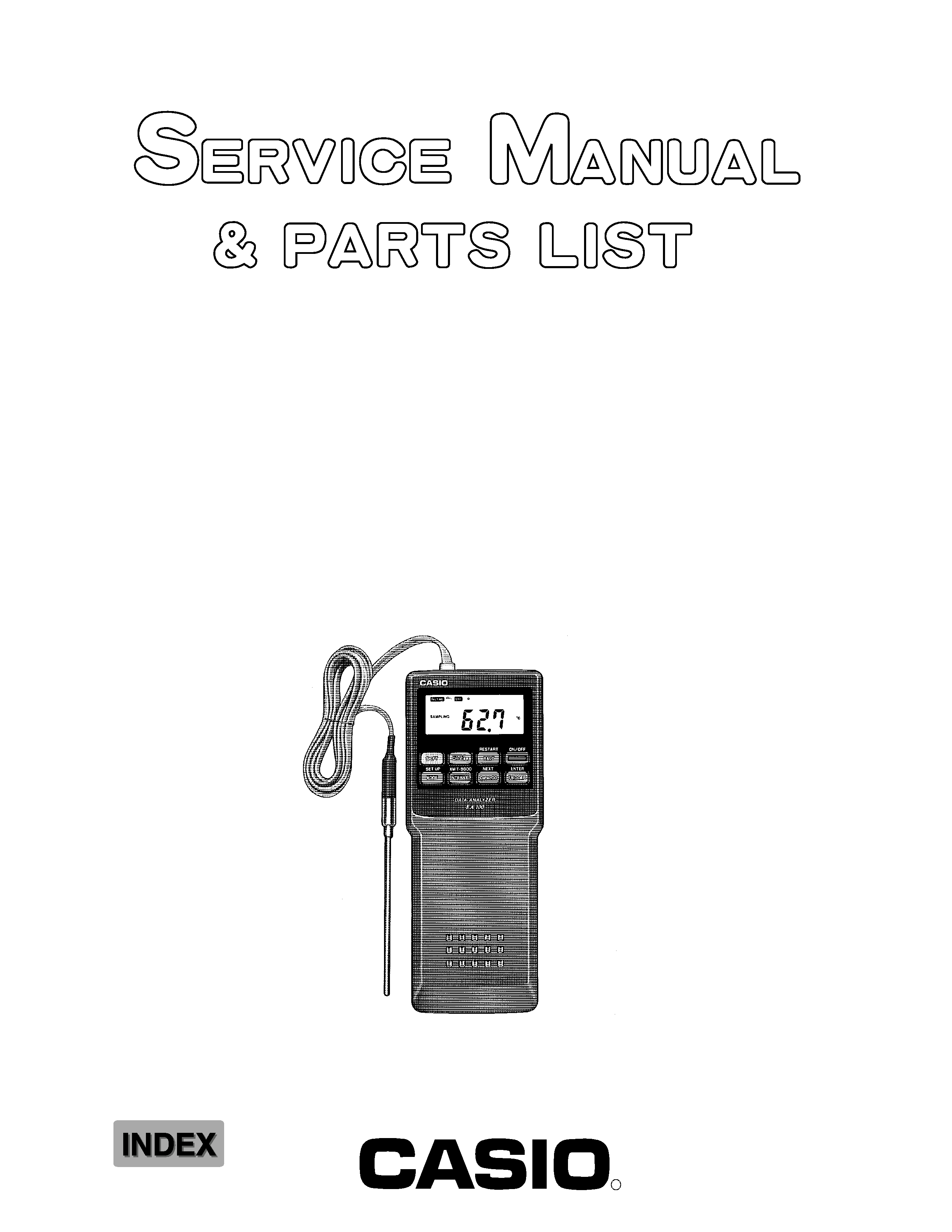
DATA ANALYZER
EA-100(ZX-953)
R
AUG. 1996
EA-100
(without price)

CONTENTS
1. CASIO DATA ANALYZER OVERVIEW ---------------------------------------------------- 1
2. SPECIFICATIONS -------------------------------------------------------------------------------- 3
3. PROBES --------------------------------------------------------------------------------------------- 4
4. KEY FUNCTIONS --------------------------------------------------------------------------------- 5
5. POWER SUPPLY -------------------------------------------------------------------------------- 6
6. CONNECTING THE DATA ANALYZER TO A CALCULATOR ---------------------- 8
7. COMMUNICATION WITH A CALCULATOR ---------------------------------------------- 9
8. TROUBLESHOOTING ------------------------------------------------------------------------- 11
9. ERROR MESSAGES --------------------------------------------------------------------------- 11
10. SCHEMATIC DIAGRAMS ------------------------------------------------------------------- 12
11. CIRCUIT EXPLANATION
11-1. Block Diagram --------------------------------------------------------------------------- 15
11-2. LSI Pin Function ----------------------------------------------------------------------- 16
11-3. Circuit Explanation ------------------------------------------------------------------- 17
12. OPERATION CHECK
12-1. Low Battery Check -------------------------------------------------------------------- 18
12-2. Operation Check (LCD, KEY, RAM and ROM) -------------------------------- 18
12-3. Communication Check --------------------------------------------------------------- 20
13. PARTS LIST -------------------------------------------------------------------------------------- 22
14. EXPLODED VIEW ------------------------------------------------------------------------------ 24

-- 1 --
1. CASIO DATA ANALYZER OVERVIEW
The CASIO Data Analyzer is a digital instrument you can use to sample and collect data on various
everyday natural phenomena. The following sections provide information on using its probes and
channels, and tell you how to connect to a graphic scientific calculator. A number of other important
functions of the data analyzer unit are also introduced here.
Sample Data
The probes that come with the CASIO Data Analyzer make it possible to sample temperature, light,
and voltage. Data sampling can be performed at up to 512 points per channel, and data can be
sampled on up to five channels simultaneously. Data can be transferred to a CASIO CFX-9850G or
CFX-9800G graphic scientific calculator as it is sampled.
Probes
Probes are actually sensors for picking up data on temperature, light, and other natural phenomena.
When using the supplied probes, the data analyzer unit's Auto-ID feature automatically detects which
of the probes is connected.
Channels
Probes are connected to input/output terminals, called "channels," that are equipped on the data
analyzer unit. There are a total of six channels for connection of probes: three analog channels (CH1,
CH2, CH3), one ultrasonic channel (SONIC), one digital input channel (DIG IN), and one digital output
channel (DIG OUT).
Data Analyzer and the CFX-9850G/CFX-9800G
Though the data analyzer unit can be used alone to sample, store, and recall data, you can also
connect to a graphic scientific calculator for more detailed manipulation and analysis of sampled data.
The data analyzer unit can be controlled from the calculator, and sampled data can be displayed in
graphic form on the calculator's screen.
Control of the data analyzer unit is performed by sending calculator list data (CFX-9850G) or matrix
data (CFX-9800G), which the data analyzer unit interprets as commands.
The data analyzer unit can be linked to a CFX-9850G or CFX-9800G graphic scientific calculator by
connecting the input/output terminals equipped on each unit with a data communication cable (SB-
62).
Command and Programs
There are a total of 10 commands defined for this data analyzer unit: Command 0 through Command
9. These commands can be used to specify such parameters as the type of data being sampled, the
channel being used for sampling, the sample time, and the number of samples. Commands are sent
from a connected graphic scientific calculator (CFX-9850G/CFX-9800G) to the data analyzer unit,
which then executes them.
A program is a set of multiple commands that cause the data analyzer unit to perform a series of
actions. For example, you could send a set of commands that tell the data analyzer unit to set up, to
sample some data, and then send the data back to the calculator. Data analyzer unit programs can be
written using the CFX-9850G graphic scientific calculator's program function only. Be sure to read the
documentation that comes with the CFX-9850G to thoroughly familiarize yourself with the program-
ming function before trying to use it to control this data analyzer unit.

-- 2 --
Conversion Equations and Post-processing
Conversion Equations
The physical units measured by the probes are converted into a more easily understood unit of mea-
surement by built-in conversion equations. In the case of the temperature probe, for example, changes
in temperature are measured by fluctuations in electrical resistance by an electrical device called a
"thermistor." The conversion equation converts the measured resistance value to a temperature unit
(such as degrees Celsius) and produces the converted value on its screen. Each of the analog chan-
nels and the SONIC channel has its own built-in conversion equation.
Post-processing
The data analyzer unit provides the means to perform certain calculations using sampled data when
required. This is called "post-processing" (processing of data after it is sampled).
This data analyzer unit supports three types of post-processing: first derivative, first and second de-
rivatives, and statistics. Selecting first and second derivatives for post processing, for example, calcu-
lates the first and second derivatives* for the sample data and stores the result into memory. Selecting
statistics calculates the mean, standard deviation, minimum and maximum for the sampled data and
stores them in memory. Calculated data can also be downloaded to a graphic scientific calculator.
*
The term "derivative" here means "time increment."
Data Filtering
Static "noise" can sometimes cause sampled data to become corrupted, making it impossible to ob-
tain accurate results from calculations and analysis. This data analyzer unit includes a data filtering
system that eliminates noise and help to make sure that data is always accurate.

-- 3 --
2. SPECIFICATIONS
Model:
CASIO EA-100 Data Analyzer
Power supply:
Four AA-size batteries (LR06 (AM3) or R6P (SUM-3)) or
optional AC adaptor (AD-A60024)
Current consumption:
ON (*Multi-meter mode): 45 mA (TYP.)/57 mA (MAX.)
(INPUT: DC 6 V)
OFF:
10
µA (MAX.)
* Multi-meter mode: Press ON/OFF button, then press MODE button.
Power consumption:
1.5 W
Battery life:
LR06 (AM3):
Approximately 12 hours (Continuous Multi-
meter Mode) / Approximately two years
(when is left with power off)
R6P (SUM-3): Approximately 7 hours (Continuous Multi-
meter Mode) / Approximatery two years
(when is left with power off)
Auto power off:
Approximately 10 minutes after last key operation. See
page 7 for information on conditions under which Auto
Power Off is disabled.
Operating Temperature:
0
°C to 40 °C (EA-100)
The tip of the temperature probe can be used in tem-
peratures ranging from 20
°C to 130 °C.
Dimensions:
86 (W)
× 214.5 (D) × 32.2 (H) mm
Weight:
305.5 g (including batteries)
Standard accessories:
Light Probe (CDAP-01); Temperature Probe (CDAP-02);
Voltage Probe (CDAP-03); four AA-size batteries (R6P
(SUM-3)); Data Communication Cable (SB-62); Carry-
ing Case; User's Guide
